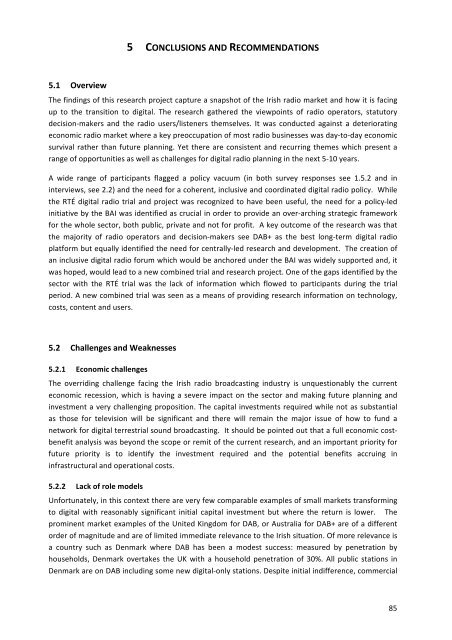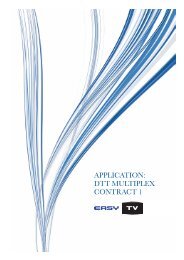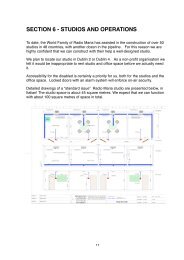Digital Radio for Ireland: Competing Options, Public Expectations - BCI
Digital Radio for Ireland: Competing Options, Public Expectations - BCI
Digital Radio for Ireland: Competing Options, Public Expectations - BCI
Create successful ePaper yourself
Turn your PDF publications into a flip-book with our unique Google optimized e-Paper software.
<br />
5.1 Overview <br />
5 CONCLUSIONS AND RECOMMENDATIONS <br />
The findings of this research project capture a snapshot of the Irish radio market and how it is facing <br />
up to the transition to digital. The research gathered the viewpoints of radio operators, statutory <br />
decision‐makers and the radio users/listeners themselves. It was conducted against a deteriorating <br />
economic radio market where a key preoccupation of most radio businesses was day‐to‐day economic <br />
survival rather than future planning. Yet there are consistent and recurring themes which present a <br />
range of opportunities as well as challenges <strong>for</strong> digital radio planning in the next 5‐10 years. <br />
A wide range of participants flagged a policy vacuum (in both survey responses see 1.5.2 and in <br />
interviews, see 2.2) and the need <strong>for</strong> a coherent, inclusive and coordinated digital radio policy. While <br />
the RTÉ digital radio trial and project was recognized to have been useful, the need <strong>for</strong> a policy‐led <br />
initiative by the BAI was identified as crucial in order to provide an over‐arching strategic framework <br />
<strong>for</strong> the whole sector, both public, private and not <strong>for</strong> profit. A key outcome of the research was that <br />
the majority of radio operators and decision‐makers see DAB+ as the best long‐term digital radio <br />
plat<strong>for</strong>m but equally identified the need <strong>for</strong> centrally‐led research and development. The creation of <br />
an inclusive digital radio <strong>for</strong>um which would be anchored under the BAI was widely supported and, it <br />
was hoped, would lead to a new combined trial and research project. One of the gaps identified by the <br />
sector with the RTÉ trial was the lack of in<strong>for</strong>mation which flowed to participants during the trial <br />
period. A new combined trial was seen as a means of providing research in<strong>for</strong>mation on technology, <br />
costs, content and users. <br />
<br />
5.2 Challenges and Weaknesses <br />
5.2.1 Economic challenges <br />
The overriding challenge facing the Irish radio broadcasting industry is unquestionably the current <br />
economic recession, which is having a severe impact on the sector and making future planning and <br />
investment a very challenging proposition. The capital investments required while not as substantial <br />
as those <strong>for</strong> television will be significant and there will remain the major issue of how to fund a <br />
network <strong>for</strong> digital terrestrial sound broadcasting. It should be pointed out that a full economic cost‐<br />
benefit analysis was beyond the scope or remit of the current research, and an important priority <strong>for</strong> <br />
future priority is to identify the investment required and the potential benefits accruing in <br />
infrastructural and operational costs. <br />
5.2.2 Lack of role models <br />
Un<strong>for</strong>tunately, in this context there are very few comparable examples of small markets trans<strong>for</strong>ming <br />
to digital with reasonably significant initial capital investment but where the return is lower. The <br />
prominent market examples of the United Kingdom <strong>for</strong> DAB, or Australia <strong>for</strong> DAB+ are of a different <br />
order of magnitude and are of limited immediate relevance to the Irish situation. Of more relevance is <br />
a country such as Denmark where DAB has been a modest success: measured by penetration by <br />
households, Denmark overtakes the UK with a household penetration of 30%. All public stations in <br />
Denmark are on DAB including some new digital‐only stations. Despite initial indifference, commercial <br />
85






